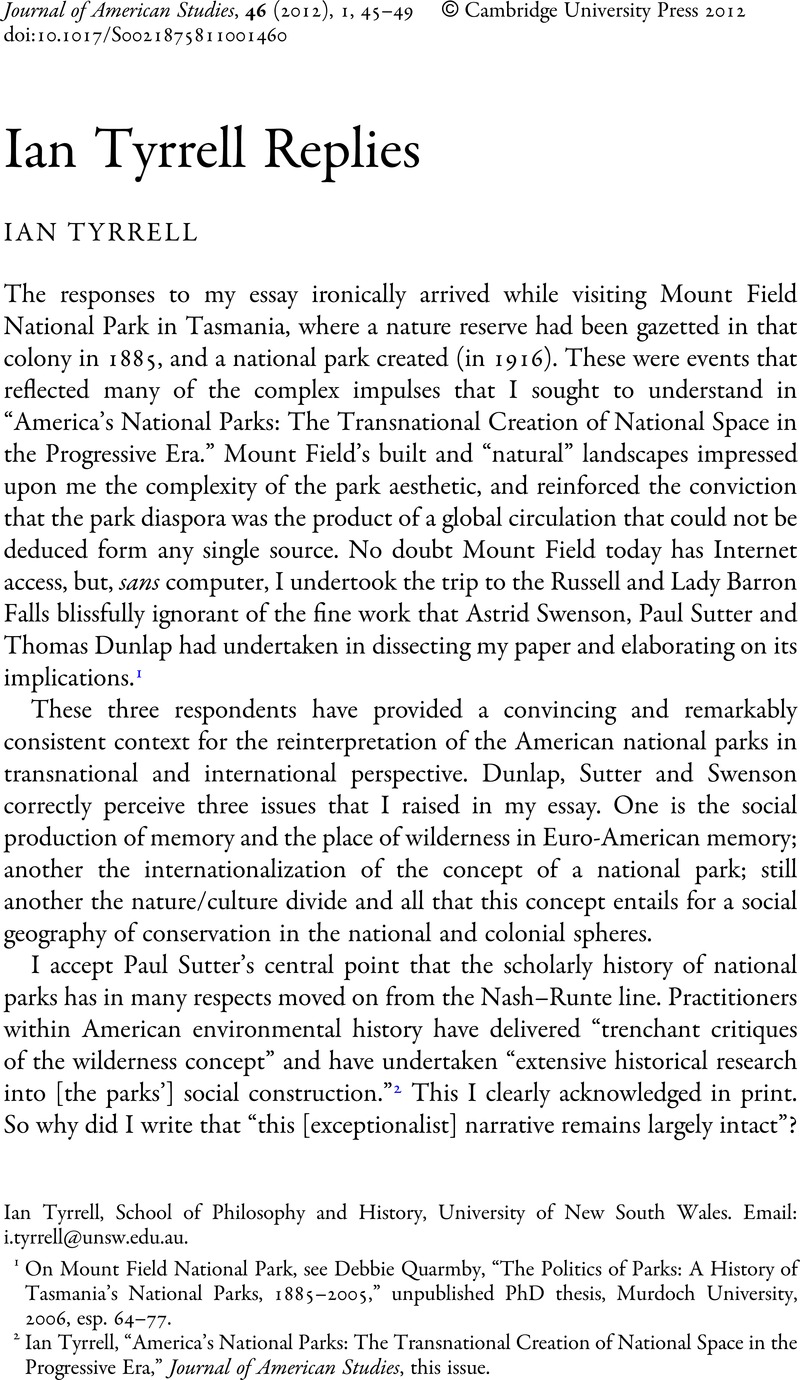No CrossRef data available.
Article contents
Ian Tyrrell Replies
Published online by Cambridge University Press: 09 March 2012
Abstract

- Type
- Research Article
- Information
- Copyright
- Copyright © Cambridge University Press 2012
References
1 On Mount Field National Park, see Debbie Quarmby, “The Politics of Parks: A History of Tasmania's National Parks, 1885–2005,” unpublished PhD thesis, Murdoch University, 2006, esp. 64–77.
2 Ian Tyrrell, “America's National Parks: The Transnational Creation of National Space in the Progressive Era,” Journal of American Studies, this issue.
3 Cronon, William, “The Trouble with Wilderness, or, Getting Back to the Wrong Nature,” Environmental History, 1 (Jan. 1996), 7–28CrossRefGoogle Scholar; Jacoby, Karl, Crimes against Nature: Poachers, Squatters, Thieves, and the Hidden History of American Conservation (Berkeley: University of California Press, 2001)Google Scholar; Warren, Louis, The Hunter's Game: Poachers and Conservationists in Twentieth-Century America (New Haven: Yale University Press, 1997)Google Scholar; Spence, Mark David, Dispossessing the Wilderness: Indian Removal and the Making of the National Parks (New York: Oxford University Press, 1999)Google Scholar.
4 See http://www.pbs.org/nationalparks/share-your-story/assets/templates/nationalparks/national_browse.php, accessed 8 Dec. 2011. I agree with Sutter's review of Burns's series, which is soporific and ponderous in effect, and hence irritating. This raises again the question why it received such favourable public reception. Paul Sutter, review of The National Parks: America's Best Idea in Journal of American History, 97 (Dec. 2010), 892–96.
5 Sellars, Richard W., Preserving Nature in the National Parks: A History (New Haven: Yale University Press, 1999)Google Scholar.
6 Tyrrell, Ian, Historians in Public: The Practice of American History, 1890–1970 (Chicago: University of Chicago Press, 2005), 173–74Google Scholar.
7 For an example see Mels, Tom, Wild Landscapes: The Cultural Nature of Swedish National Parks (Lund: Lund University Press, 1999), 81Google Scholar.
8 Dunlap, Thomas, Nature and the English Diaspora: Environment and History in the United States, Canada, Australia, and New Zealand (New York: Cambridge University Press, 1999)Google Scholar.
9 Grove, Richard, Green Imperialism: Colonial Expansion, Tropical Island Edens and the Origins of Environmentalism, 1600–1860 (Cambridge and New York: Cambridge University Press, 1995)Google Scholar.
10 Willis, Bailey W., Northern Patagonia: Character and Resources: Text and Maps by the Comisión de estudios hidrológicos, Bailey Willis, Director, 1911–1914 (New York: Scribner, 1914)Google Scholar.
11 Sutter, review of The National Parks, 896.
12 Richard White and Melissa Harper, “How Transnational were the First National Parks? Comparative Perspectives from the British Settler Societies,” in Civilizing Nature: National Parks In Transnational Historical Perspective, Conference at the German Historical Institute, 12–14 June 2008. Copy courtesy of Richard White.
13 See also Paul Sutter, “Putting Wilderness in Context: The Interwar Origins of the Modern Wilderness Movement,” in Michael Lewis, ed., American Wilderness: A New History (New York: Oxford University Press, 2007), 168–83.
14 Rosenzweig, Roy and Blackmar, Elizabeth, The Park and the People: A History of Central Park (Ithaca, NY: Cornell University Press, 1992)Google Scholar, esp. chap. 7; Irwin, William R., New Niagara: Tourism, Technology, and the Landscape of Niagara Falls, 1776–1917 (University Park, PA: Penn State University Press, 1996)Google Scholar.
15 ASHPS, Sixteenth Annual Report, 1911, 555; ASHPS, Nineteenth Annual Report, 1914, 320 (“untouched”); ASPS, Eighteenth Annual Report, 1913, 277 (“wild”).
16 James Bryce, “National Parks – The Need of the Future,” American Civic Association, [Pamphlets] Series 11, No. 6, December 1912, 6–13, 10.
17 This latter point is missing in Sellars, Preserving Nature in the National Parks, chaps. 1–2.




